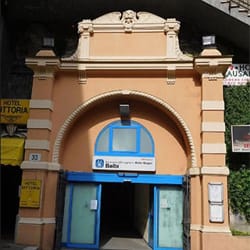In this charming valley behind Genoa, along the banks of the Scrivia river, the cultivation of the rose is in fact an ancient tradition, which dates back to the 1600s.
In this particular area of our beautiful region there are several rose gardens and, around them, many local shops sell locally-made products with rose petals such as rose syrups, rose perfumes, rose jellies, rose soaps and even rose candies.
In this province, there is a huge farm called the Garden of the Dahlias which has as goal safeguarding the tradition linked to Ligurian products made with roses. Among them is the rose syrup from the Scrivia Valley, which is now a Slow Food presidium (which means a product added to the Slow Food list of traditional products worth preserving). The varieties of roses used in the processing of syrup are above all the Centifolia and the Rugosa kinds. They are considered to be particularly fragrant and with the right amount of essential oil in their petals to do the trick.
The cultivation of roses in the Scrivia Valley and the consequent production of rose syrup is supported and promoted by the Le Rose della Valle le Scrivia Association.
In the garden of the Dahlias, located within a beautiful historic mansion from the mid-eighteenth century once used as a hospital, there is a terraced courtyard, adorned with hanging rose bushes and a splendid flowering acacia tree.The smell of the rose syrup rose is all around.
The garden was created as a support to the activity of the ancient hospital and, for the care of the sick, the ‘apothecary’ cultivated numerous plants, mainly roses.
As the locals tell us, roses have always been cultivated in this valley and, back in the past, each family had only a few plants, made syrup and other preserves only for themselves. At the end of the 1990s, with the proposal of a famous Genoese pastry chef, the need for a more coordinated and intensive production of syrup and jellies was born.
Roses normally bloom from mid-May to the end of June.
The syrup is made a little at a time as the fresh petals are collected and processed as soon as possible. The ancient recipe is handed down orally and is not written and it should not be written. The ingredients are very few and simple: water, sugar, lemon juice and rose petals.
The syrup is used in hot water as a tea in the Winter and in cold water with ice in the Summer.
It is said to have relaxing properties and it’s a very quenching drink in hot Summer days.
It is excellent also when used over vanilla ice-cream to make sundaes or in the preparation of cakes.
With its intense color and aroma, rose syrup is linked to the things of the past, to memories and refined pleasures of childhood because it is especially given to children to soothe them. For the Genoese people it is so present in their hearts that at times we buy it to recall our childhood.
The rose has the unique power of essential oils and, since it has a soothing power, it is associated with relaxation so it is thought that massaging the chest using a few drops of rose essence can alleviate wounds and even sadness.
Here in Liguria we also make yummy rose jelly, used as a spread on bread, and rose perfume, which is very sweet and for women only.

Locally bought handmade rose syrup






























































